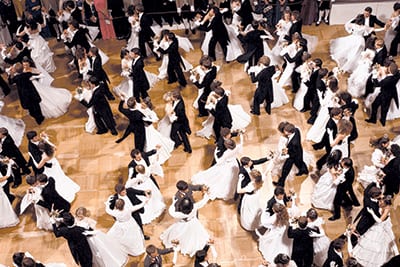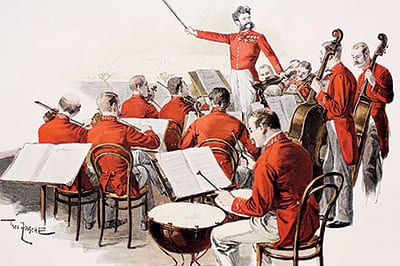Once considered wicked, today it is the very definition of all things Viennese: the Viennese waltz. The people of Vienna love it, the music – made world famous 150 years ago by waltz king Johann Strauss – as well as as the dance of the same name in three-four time, which is a fixed item at every ball
Schubert, Chopin, Liszt, Brahms and Mahler wrote waltzes that are not intended to be danced to but rather as a song, for piano or orchestra. However, it was the danceable waltzes of the Strauss dynasty that triumphed around the world like no other. Dancing the waltz – that was and is the Viennese way of partying. Nowhere else is that so keenly celebrated as at the Viennese balls.
Viennese ball culture had its beginnings about 200 years ago when Europe was being restructured at the Congress of Vienna in 1814/15. An effort was made to make the negotiating guests’ stay more pleasant with balls and social events. The catchphrase was: “The Congress is dancing”. The whole of Vienna swayed in three-four time and became the city of the waltz.

When it came to dancing music, the public expected a constant stream of new waltzes or polkas. Composers such as Joseph Lanner, Johann Strauss Sr. and Jr. supplied quantity and quality – and often conducted their works. They were celebrated like pop stars. Johann Strauss Sr. (1804-1849) composed the “Radetzky March”. Johann Strauss Jr. (1825-1899) went down in history as the “Waltz King”, his concert tours taking him to Russia and America. His brothers Josef and Eduard also made music. Interesting information about the whole Strauss dynasty can be gleaned nowadays in the Strauss Museum.
BLUE DANUBE WALTZ – THE FIRST HIT
Perhaps Strauss Jr.’s most famous work is the Blue Danube Waltz, actually entitled “On the beautiful, blue Danube”. It was composed in Strauss’ apartment at Praterstrasse 54, which has been preserved in its original state. On 17 February 1867, the ‘Neues Fremdenblatt’ wrote about the acclaimed premiere: “The opening number of the second movement was a decisive hit” – the first recorded use of the term ‘hit’.
Viennese ball culture had its beginnings about 200 years ago, when Europe was being restructured at the Congress of Vienna in 1814/15
The nine-minute, would-be national anthem of Austria is regularly played at the change of year, for example as an encore and highpoint of the globally broadcast New Year’s Concert of the Vienna Philharmonic and at Viennese balls, which are also a unique experience for visitors to Vienna.
Each Viennese ball usually adheres to a strict dress code. If you get the evening attire (totally) wrong, you may not be allowed to enter, even with a valid ticket.

The dress code for elegant balls is usually long ball gowns for the ladies and tuxedos, tailcoats or black suits (depending on the respective dress code of each organiser) for the gentlemen. With modern balls, such as the Life Ball, the dress code can be themed and quite extravagant.
The journey from non-dancer to ball-ready is a short one with the assistance of the Vienna Dance Schools. The dance consists of just six steps; what makes it challenging is the high speed. Experienced dancers alternate the right-hand waltz with the more difficult variant in the opposite direction. Those who become dizzy from the rapid turning (tip: always look in the direction you’re dancing and especially never at the floor!) or find their path blocked on a busy dance floor, can steal a couple of quiet rock steps on the spot.
By the way: someone who dances twelve waltzes in a single evening will have completed about an hour of physical exercise, including 2,500 turns, 5,000 steps and a distance of 5 kilometres.